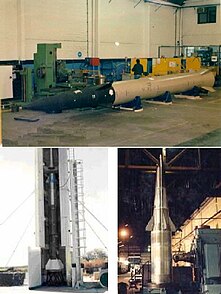Argentine Cóndor missile
The Cóndor missile was a military missile project of the Argentine armed forces.
Background: Argentine-German aerospace engineering
In 1947 the former technical director of the Focke-Wulf works in Bremen, Kurt Tank , headed the Argentine jet program. Tank replaced the French aircraft designer Émile Dewoitine there. In the spring of 1948 the Focke-Wulf aircraft engineer Hans-Gerd Eytin and Gerhard Bohne were brought to Genoa via Prien near Salzburg; Krunoslav Draganović had signed a residence permit for her - Eytin became the Croatian displaced person Antonio Kohavic with a CIRC card.
An attempt to transfer Erich Bachem with Samuel Pomerance, who died in December 1948 during the project "Velvetta 2" (the transfer of a Supermarine Spitfire from Okres České Budějovice to Cyprus) failed at Lake Constance.
The Argentine Cóndor missile program began in the 1970s as a multinational aerospace program with the substantial participation of Messerschmitt-Bölkow-Blohm . The originally developed Argentine Cóndor missile had little military capabilities, with it experience was gained that flowed into the development of the Alacrán program (Castillian for scorpion), which developed a functional short-range surface-to-surface missile.
Allegedly a French embargo on Exocet missiles became partially effective during the Falklands War , which was used by the Argentine Air Force as an argument for efforts (allocation of budgetary funds) for a medium-range missile program called Cóndor II. The program was advanced in close cooperation with the Egyptian and Iraqi air forces. In the early 1990s, President Carlos Menem interrupted the program due to political pressure from the United States. The rocket was manufactured in Falda del Carmen, Santa María department in the province of Cordoba .
It is believed that the Libyan Air Force joined the Cóndor II project around 1995. The status of Libyan missile development is unknown, but it is believed that cooperation with the Argentine Air Force has been the most promising. In 1997, the Argentine Air Force reported to the Argentine Congress that it still had two of the missiles that would be destroyed. There have been extensive reports of a Cóndor III program. The Cóndor III would have a range of 1500 km with the same weapon load as the Cóndor II.
This program may not have been funded since the fall of Saddam Hussein in Iraq in 2003 .
Condor missile
- Length: 10.50 m
- Diameter: 0.80 m
- Weight: 5.2 t
- Drive: two-stage, solid / liquid
- Range: 900 km
- Warhead: one, explosive or chemical, 450 kg
Cóndor I
- Length: 8 m
- Diameter: 0.80 m
- Drive: single-stage, solid hydroxyl terminated poly butadiene ( HTPB )
- Fuel: Obtained from the manufacturing plant in Falda del Carmen, Córdoba
- Lining of the nozzles: made of epoxy resin - molybdenum trioxide
- Shell: exopid resin
- Control system: through inertia and guide surfaces
- Service ceiling: 300 km
- Range: 100 km
- Warhead: not included, explosive or chemical, 500 kg
The Cóndor I was used to develop rocket engines and was later to be used for atmospheric studies. The drive was statically tested in 1983 before the democratically elected government took office. The planned launch of the first Cóndor I in 1985 was not carried out.
Cóndor II beta
The Alacrán Cóndor IA III is considered the development stage of the Cóndor II. Task: tactical weapon
- Length: 6.5 m
- maximum diameter 0.56 m
- Drive: single-stage, solid hydroxyl terminated poly butadiene (HTPB)
- Fuel procurement at the manufacturing plant in Falda del Carmen, Córdoba
- Fixed nozzle
- The nozzles are made from molybdenum trioxide epoxy resin
- Shell exopid resin
- Service ceiling: 115 km
- Range: 100 km
- Warhead: Cluster bomb 1000 CAM-1 shells, 250 kg
Although the rocket had not previously passed flight tests, some specimens were launched on various occasions, for example in 1988 on the occasion of the CEPAL summit in Chamical , La Rioja . The missile was also intended to serve as a scatter grenade carrier.
In February 1990 the Argentine Air Force was working on the project of a surface-to-surface missile VT-561 , the Alacrán successor model Proyecto FAS-320 .
- Total weight: 1.5 t, weapon load 400 kg
- Empty weight: 788 kg
- Fuel weight: 744 kg
- horizontal range: 120 km
- Service ceiling: 40 km
Cóndor II
- Length: 10.98 m
- maximum diameter 1.01 m
- Drive: two-stage, solid hydroxyl terminated poly butadiene (HTPB)
- Fuel procurement at the manufacturing plant in Falda del Carmen, Córdoba
- Nozzle controllable in both stages
- Flight path control aerodynamic
- The nozzles are made from molybdenum trioxide epoxy resin
- Shell exopid resin
- Service ceiling: 115 km
- Range: 890 km
- Warhead: 500 kg
- Total weight: 6.5 t
The Cóndor II was a two-stage rocket with control by moving nozzles in both stages, it had an attitude control system and a terminal speed control. This was checked by three computers.
A few examples of the Cóndor II were made without being tested in flight. The project was terminated for budgetary reasons resulting from international pressure. According to an agreement between the governments of the time, a large part of the missile manufacturing equipment was dismantled and destroyed in the USA in 1993.
The Castillian language version of the article complains that since then there has been no civil spaceflight in Argentina, this is described here: Comisión Nacional de Actividades Espaciales .
Individual evidence
- ↑ focus.de (October 18, 1999): AFFAIR: Blood and Brothers in Arms. Accessed February 21, 2011
- ↑ Cluster munitions: time to act - Flash video version

